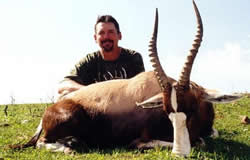


| Name | Bontebok |
| Scientific Name | Damaliscus dorcas dorcas |
| Average Weight Male | 61 Kg |
| Average Weight Female | 58 kg |
| Shoulder Height Male | 95 cm |
| Shoulder Height Female | 90 cm |
| Mating Season | April/May may differ from area to area |

The Bontebok is a closely related to the Blesbok. The two species can often be confused, however the Bontebok tends to be much more colorful with much more white evident on the face,
rump and legs. The prominent white blaze on the face and forehead of the Bontebok tends to merge. The Ewes tend to be somewhat smaller than the Rams and they prefer to form herds
of separate sexes. Hunt the Bontebok early in the morning and late in the afternoon, as these are the times he prefers to graze.
The Bontebok tends to lay up during the heat
of the mid-day sun. The Bontebok has been on the endangered list but game ranching in Southern Africa has brought his numbers back and there are sustainable numbers now to allow hunting.
Your favorite deer rifle will be adequate for hunting Bontebok, a .270, 7mm, or one of the 30 calibers will do quite nicely. This beautiful antelope was indigenous only to the plains of South
Africa, but game ranching has made him available in many places these days. Use good quality bullets as with all African game and if hunting the plains, remember that your shots might have to
be made at considerable distances. The Bontebok is listed under CITES 1, which requires both an export permit as well as an import permit. If you intend to take Bontebok on your Safari,
be sure that the proper permits are available and secured prior to your hunt.